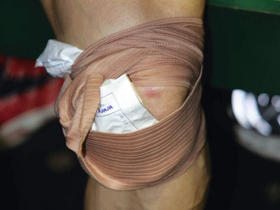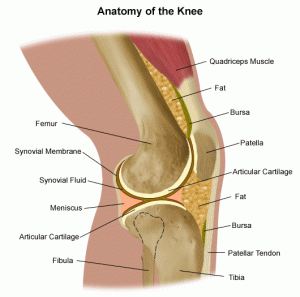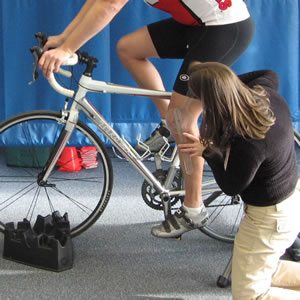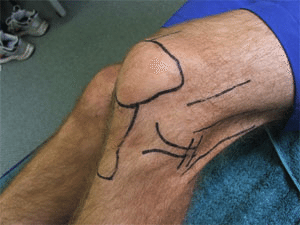
[dc]W[/dc]ith spring rearing it's much welcomed head, a lot of riders are in the midst of building fitness towards their early season racing programs. A lot more are just ramping it up getting ready for the beck and call of sweaty summer club throwdowns. But whether you've been riding hard since December, hoping to podium at that spring "classic" or you're just starting up your training, one thing can slow all of us to a crawl: knee pain. At some point in our cycling lifetime we'll all experience it, and we'll all know the suffering of sitting on the couch while we wonder "why me" or "why now?"
Instead of asking those questions, it's more prudent to ask "what caused this" along with treating the symptoms that put you out of commission. Here we'll take a quick look at some of the reasons your knees may be throbbing and help you shed some light on why you're couch surfing.
Understanding Anatomy and Function
To understand what causes knee issues, we should start with a quick anatomy lesson. The knee is basically a diarthrodial hinge joint between the femur and the tibia. Huh? It's a hinge joint between the thigh bone and shin bone with a capsule around it. While the bony and ligamentous structure is relatively vulnerable, powerful muscles stabilize the joint against injury, namely the quadriceps and hamstrings. The former acts to extend the knee by attaching to the tibia via the patella (kneecap). The latter is part of the series of muscles that flexes the knee as well as extending the hip (along with the glutes, it forms part of the power stroke as detailed here.)
 The joint between the patella and femur (patellofemoral joint or PFJ) deserves special mention. The patella is a sesamoid bone, surrounded by the patellar tendon and serves a primary function of changing the lever arm through with the force of the quadriceps is applied. Again, huh? It's a small floating bone that makes the quads work more efficiently. But more than that, the PFJ is often a source of pain as the joint itself is compressed with each flex of the knee during the pedal stroke, and this can be made worse by various intrinsic and extrinsic conditions.
The joint between the patella and femur (patellofemoral joint or PFJ) deserves special mention. The patella is a sesamoid bone, surrounded by the patellar tendon and serves a primary function of changing the lever arm through with the force of the quadriceps is applied. Again, huh? It's a small floating bone that makes the quads work more efficiently. But more than that, the PFJ is often a source of pain as the joint itself is compressed with each flex of the knee during the pedal stroke, and this can be made worse by various intrinsic and extrinsic conditions.
In terms of muscular involvement, typically the contributions of the quads, hamstrings (and to a lesser extent the gastroc) are all finely balanced. Each muscle pulls the knee from a specific angle with a specific amount of force, and it doesn't take much for that balance to be upset. Improperly aligned cleats, incorrect saddle height, poor pedaling form, previous knee injuries….these can all lead to some kind of repetitive motion injury, or overuse injury, which is the most common variety of cycling injury.
Before we go any further, it is worth noting that internal derangement of the knee can be a significant source of pain for a cyclist. These type of injuries can include anterior and posterior cruciate ligament (ACL/PCL) damage, meniscal damage, lateral and medial collateral (LCL/MCL) damage or injury to the cartilaginous surfaces in the joint. Luckily, these injuries are typically of the acute traumatic variety: most are caused by a sideways impact on a knee during a time when the foot is stable and planted. Occasionally, non-contact injuries occur when an athlete plants the foot and tries to pivot on the knee (see Robert Griffin III's knee injury). The nature of cycling generally precludes athletes from experiencing these force vectors on the bike (except perhaps in very rare occasions during crashes) and generally rules out these acute injuries from a differential diagnosis. This leaves us with repetitive motion/overuse injuries as the likely culprit of the average cyclist's knee pain.
That being said, what is repetitive motion injury?
Repetitive Motion
Imagine this: on a 4 hour ride, with an average cadence of 85 RPM, we make 20,400 pedal strokes, each one basically the same as the last. There is no doubt about the fact that cycling is a repetitive motion sport. Every single pedal stroke flexes and extends (not fully) the knee: the power stroke starts with about 115 degrees of flexion and continues to about 30 degrees of flexion before the pulling phase of the pedal stroke begins. Any disruption to a perfectly executed pedal stroke can lead to an overuse injury.
The injury part of an overuse injury simply comes from the fact that the amount of training and microtrauma (which is impossible to completely eliminate from any kind of training) exceeds the body's capacity for normal function and proper repair. Essentially, something has put more stress on the body than it can properly cope with and several factors can be the culprit: your own biomechanics, your cycling program or your bike itself. So how do we figure out what caused the injury and how do we deal with it?
Causes
Biomechanical causes, sometimes referred to as "cyclist specific causes" or "intrinsic causes", are usually anatomical/physiological or pathological in nature. They are very specific to the individual cyclist and can include issues such as anatomical discrepancies (like leg length discrepancy), muscle tightness or weakness, weakened core muscles, inflexibility or history of past injury. Intrinsic causes are almost always found in conjunction with other causes of knee pain, especially when a biomechanical issue is exacerbated by some other extrinsic issue.
Leg length discrepancies, either anatomical or functional, can contribute to problems in one particular leg. Keep in mind though that we all favor one leg over another, just as we favor one hand over another. This helps to explain why we usually only have knee problems on one side. Past injury is an obvious intrinsic cause, as previous damage to a structure will often make it prone to further damage. Inflexibility and weakened core muscles can upset the fine balance of the knee's musculature and lead to overuse problems.
Cycling Specific Causes
These are extrinsic causes of injury and are usually related to a cyclist's activities. Unfortunately, the very enthusiasm that pushes us to ride longer, faster and more frequently is often the same enthusiasm that pushes us to the point of injury. Sudden increases in duration, distance or intensity of training can precipitate an injury. Changes of terrain, such as suddenly riding more, longer or steeper hills can be an issue as well. Finally, switching to a "mashing" riding style (pushing huge gears at lower cadences) can cause issues to appear. Keep in mind that these extrinsic forces typically end up causing an injury at a site of biomechanical or anatomical deficiency, but in some rare cases, they stand on their own as a cause of injury. Usually, these types of causes appear at the beginning of the season when riders begin to ramp up their training after the winter off-season.

Bike Specific Causes
These are extrinsic causes and typically involve some kind of changes in bike fit or installation of new components. New saddles, stems, bars, seat posts, pedals/cleats or cranks can all precipitate an injury if the rider is not properly fit to them. Specifically, changing the crank length (which changes the pedal to saddle distance as well as the force profile of the pedal stroke), saddle height, setback or model (which can change the biomechanical angles of the pedal stroke) or cleat alignment (which can change the biomechanical alignment of the lower leg) can bring about an injury.
Fit deserves a special mention here: there's no universally accepted method of fitting a rider to a bicycle, so each and every fitter will be different. Not all fitting methods work for all riders, so keep that in mind when changing parts. The best solution in this case is to stay with a single fit system (Serotta, Specialized, etc) throughout the changes to ensure that everything is adjusted according to the same fit system. You may need to stray outside that system if you have continuing issues that are not being resolved by the current fitting system.
Treating the Cause, Not the Effect
While it may seem obvious that to resolve a knee injury, we need to treat the knee itself, it's not always that simple. If we resolve the injury without looking at the cause of it, very often it will end up recurring several times throughout the season, and injury is one of the main ways to severely disrupt your training plan.
In terms of bike specific issues, solutions will revolve around making minute changes and allowing the body time to adapt to each change before making another one. Always note EVERYTHING you do to your bike. Keep a log that details every measurement including saddle height, pedal to saddle height, saddle setback, cleat position, etc. and always note any changes in your log before making an adjustment. In the case of cleats, a lot of riders prefer a cleat with a little bit of float over ones that lock the shoe in solidly.
Dealing with cycling specific issues similarly involves small changes and allowing the body to adapt before making further changes. In this case, a lot of solutions revolve around unloading the knee (usually more specifically the PFJ) by cutting back on steep or long climbs, spinning smaller gears with less force or cutting back on the amount of training you're doing. In some respects, preventing cycling specific issues is easier than dealing with them: it's much easier to ride a little less early in the season than it is to scale back in July when an injury rears its ugly head. Consider increasing your training no more than 10-15% per week and watch for conditions where the duration is similar, but the effort involved is significantly higher (for example, avoiding rides with bucket loads of climbing may be sage advice in the early part of the season.)
[pullquote]More than anything, vigilance and listening to your body is the best way to keep your knees in good shape. Understanding the causes of knee injury will give you a "leg up" in preventing them, keeping you on the bike longer and making you a stronger rider.[/pullquote]Cyclist specific problems are a bit tougher to address, and are often best left to a medical professional to diagnose and help treat. That said, the typical treatments for muscular issues involve heating and stretching to loosen tight, overactive muscles and therapeutic exercise to selectively strengthen muscle groups that are weak; all of these have the ultimate goal of restoring the proper tracking motion of the knee cap and reducing the pressure on the PFJ during each pedal stroke. In terms of leg length discrepancies, functional short legs can be treated with manipulative therapy and through muscle therapeutics, while anatomical short legs can be compensated for with fitting techniques such as shims under cleats in order to balance things out. Additionally, core strength should never be overlooked, as a weak core can put further strain on the legs (and by extension, the knee and PFJ.)
Finally, consider that your technique may be the culprit: a poorly developed pedal stroke with improper muscular activation patterns will sink your training as fast as any crash injury. Consider a qualified coach to assist you in resolving pedal stroke and technique issues. Not only will you notice a decrease in knee issues, you'll likely note an increase in power and speed.
More than anything, vigilance and listening to your body is the best way to keep your knees in good shape. Understanding the causes of knee injury will give you a "leg up" in preventing them, keeping you on the bike longer and making you a stronger rider.
Next time we'll take a look at the most common knee injury, Patellofemoral Syndrome in depth and offer some advice to help you shed that pain.
Questions? Comment below and I'll do my best to answer them for you.
